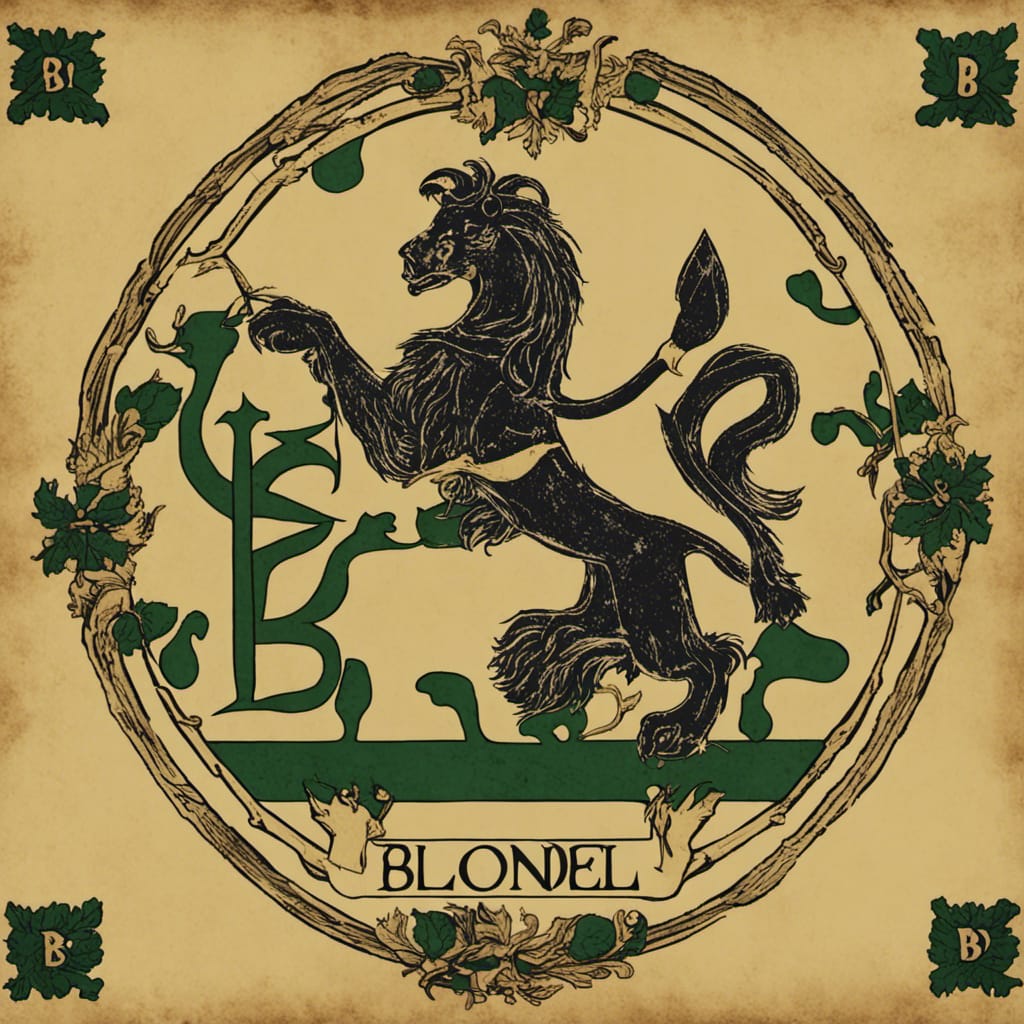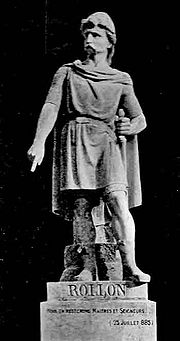


Viking Fief s and Viking BaronyRollo was a Viking leader and invader who was created the first Duke of Normandy Rollo or Gaange Rolf; (Norman: Rou; Old Norse: Hrólfr; French: Rollon; c. 846 – c. 930 AD) was a Viking who became the first ruler of Normandy, a major region of France which includes the Channel Islands. During the 9th century A.D., Norman invaders hailing from Scandinavia descended upon the northwestern shores of France. Settling primarily along the lower reaches of the River Seine, they bestowed upon the region its enduring moniker: Normandy, aptly named as the land of the Northmen. Through a series of conquests and raids, they gradually expanded their sway, seizing Rouen in 841 and conducting further incursions along the Seine valley up to Paris. The indigenous Franks found it challenging to stem the Norman tide, leading to a pivotal agreement in 911 between Charles the Simple, King of the West Franks, and Rollo, the Norman leader. This accord saw the King relinquishing territory around Rouen to the Normans, recognizing Rollo as Duke of Normandy in exchange for fealty. However, the Cotentin peninsula and the Channel Islands remained beyond Norman control until Rollo's successor, William Longsword, integrated them into his domain in 933. Thereafter, the Channel Islands became an integral part of the Duchy of Normandy, evidencing Norman administrative and legal influence that endured through the ages. Ecclesiastically, the islands fell under the jurisdiction of the diocese of Coutances, while legally, they constituted the domain of the Norman Dukes, who granted estates as fiefs to monasteries and nobles. Rollo was initially the conquerer and Chief of all Normandy and Islands, but by
the so called Christianity was established in Guernsey in the 3rd and 4th centuries and St Sampson later established a church in the island. The Bretons moved to the island from between 600AD and 800AD. In fact since around 933, when Rollo's son William Longsword added the islands to the dukedom of Normandy, the inhabitants of these islands have been answerable only to the Duke of Normandy and his successors. Edward III of England granted a Charter in July 1341 to Jersey, Guernsey, Sark and Alderney, confirming their customs and laws to secure allegiance to the English Crown. This Charter in 1341 solidifies the Fiefs and Seigneurs of Guernsey Jersey and Sark as existing land titles and titles of dignity where Noble Fiefs and FreeHolding Seigneurs and Over Lordships would remain in perpetutity. The traditional native language of Guernsey is Guernesiais (pronounced ‘JEHR-nehz-y-yay’), also known as Guernsey French or 'patois'. However, in the 11th Century Old Norse was the most widely spoken language in Europe. The region was huge and consisted of all the Nordic countries, settlements in Scotland, Ireland, England Wales, Isle of Man, Normandy, Vinland (America) and Volga (Russia) and some places in-between. As a note, William the Conqueror understood the Norse language, and the names Jersey , Guernsey , and Alderney are as truly Norse names as Orkney and Shetland. Norse was actually spoken in parts of the Contentin in North Western France in places like Bayeaux. Norse was spoken and or affected many words and traditions in feudal guernsey. Nobility of the Norse The Islands were part of the Duchy of Normandy and the Fiefs of the Channel Islands were owned by the Lords Freeholders or Freiherren of that time before baronial titles existed. In the Channel Islands including Guersey, the Queen of England is still to this day known informally as the "Duke of Normandy". The Channel Islands are the last part of the former Duchy of Normandy to remain under rule of the British monarch. The UK monarchy relinquished claims to continental Normandy and other French claims in 1259 (Treaty of Paris), the Channel Islands (except for Chausey under French sovereignty) remain Crown dependencies of the British Crown. The Fief of Thomas Blondel in the parishes of Torteval and St. Peter in the Wood is an authentic Norman title. The Seignuers (Free Lords) of Blondel existed before formal Baron titles were created. Fief Blondel is part of the former large Fief of Canelly, once held by William de Chesney (1284) and before him by the Le Canellys until the separation of Guernsey from Normandy in 1204. During 1940-1945, Guernsey was occupied by German forces and huge numbers of defensive positions were built as part of Hitler's Atlantic Wall. The Channel Islands legislatures refer to Elizabeth II in writing as "The Queen in the right of Jersey" or "The Queen in the right of Guernsey" respectively. However, the Queen is informally referred to as "The Duke of Normandy", the title used by the islanders. The Island is one of the last places on earth where feudalism exists. Fiefs are still legally recognized by the state but with limited rights. Each Fief can be up to 570-800 years old approximately. A fief owner is referred to in professional situations as a Seigneur or Dame. i.e. Free Lord or Free Lady. Many of these Guernsey fiefs are registered directly with the Crown where a treizième or conge. Conge is part of the feudal past when a due (representing one thirteenth of the property price) was charged on the property changing hands and was paid to the Seigneur of the fief upon which the property sat. It remains due and payable to the Receiver General in respect of the conveyance of fiefs. In the case of the Fief Blondel, the fee was paid by the Seigneur of Fief Blondel directly to the Crown of the United Kingdom. There may be only a few legally recognized fiefs in the world left at thist time are are directly allowed or registered with a Sovereign King or Queen. The style or title of Seigneur or Lord in the Channel Islands has historically been a Feudal Lordship or Feudal Baronnie. The channel islands have been ruled by Danes, Norwegians, Normans, Germans and so forth and the relevant title equivalent to a Seigneur would be a Frhr. Friherre, Freiherr, LHerr Lehnsherr, or Baron depending on which country you investigate.
Rollo's Family Tree:
Relationship between Rollo The Viking Chief Duke of Normandy & George Mentz - Frhr. Seigneur de Fief Blondel & Lord of Stoborough and Ennerdale.
|
Seigneur de la Fief of Blondel Lord Baron Mentz of Fief Blondel Geurnsey Crown Dependency Seigneur Fief of Blondel George Mentz Lord Baron of Fiefdom Blondel Freiherr of Fief Thomas Blondel Feudal Lord of Baronnie - Noble Fief Barony Friherre > Viking Kingdom Seigneurs and Dames Travel Research Lord Paramount Feudal Barons The Seigneur Order Patron George Mentz Charter of Liberties Deed & Title Fief Blondel Islands Viking Kingdom Fief Worship Fiefs of the Islands ECS Extended Continental Shelf Styles and Dignities Territorial Waters Blondel Privy Seal Fief Bouvees of Fief Thomas Blondel Guernsey Court of Chief Pleas Fief Court Arms Motto Flower Fief de l'Eperon La Genouinne Kingdom of West Francia Fief DuQuemin Bouvée Phlipot Pain Bouvée Torquetil Bouvée Bourgeon Bailiwick of Ennerdale Channel Island History Fief Direct from the Crown A Funny Think Happened On the Way to the Fief Guernsey Bailiwick of Guernsey - Crown Dependency Confederation des Iles Anglo-Normandes Sovereignty Papal Bull Research Links Norse Normandy Order of the Genet Order of the Genet Order of the Star Est. 1022 Knights of theThistle of Bourbon Count of Anjou Fief Rights Blondel and King Richard Press Carnival Manorial Incidents Appointments of Seigneurs Store Portelet Beach Roquaine Bay Neustrasia Columbier Dovecote Fief Blondel Merchandise Fief Blondel Beaches Islands Foreshore Events Fiefs For Sale Sold Lords of Normandy Fief Coin Viscounts de Contentin Fief Blondel Map Feudal Guernsey Titles Board of Trustees The Feudal System Hereditaments Chancellor Flag & Arms Fief Videos Guernsey Castle Sark Contact Advowson Site Map Disclaimer Freiherr Livres de perchage Lord Baron Longford Income Tax Guernsey Valliscaulian Order Saint Benedict of the Celestines Society of Divine Compassion Dictionary Count of Mortain Seigneur de Saint-Sauveur Seigneur of Fief Ansquetil Top Success Books Datuk Seri George Mentz Order St. Benedict OSB Celestines Order of the Iron Crown Order of the White Falcon Colonel Mentz Order Red Eagle Order St. Louis Order Holy Ghost Order of Saint Anthony Order of the Black Swan Order of St Columban Order of the Iron Helmet Livonian Brothers of the Sword Fief treizième and Direct from Crown Valuation Fief Blondel Prince of Annaly Teffia
Feudal Lord of the Fief Blondel of the Nordic Channel Islands Guernsey Est.
1179
Feudalherr - Fief Blondel von der Nordischen Insel Guernsey Est. 1179
New York Gazette - Magazine of Wall Street -
George Mentz -
George Mentz - Aspen Commission - Mentz Arms
Counselor George Mentz Esq. - Seigneur Feif BlondelBaron Annaly Baron Moyashel Grants to Delvin About Longford Styles and Dignities The Seigneur Court Barons Fiefs of the Islands Longford Map The Island Lords Market & Fair Fief Worship Channel Island History Fief Blondel Lord Baron Longford Fief Rights Fief Blondel Merchandise Events Blondel and King Richard Fief Coin Feudal Guernsey Titles The Feudal System Flag & Arms Castle Site Map Disclaimer Blondel Myth DictionaryMentz Scholarship Program 101 Million Donation - Order of the Genet Knighthood |





George Mentz Education -
Commissioner George Mentz
-
https://finance.yahoo.com/news/commissioner-george-mentz-clinches-influencer-180000705.html
-
George Mentz News -
George Mentz Net Worth - George Mentz Noble Tilte -
George Mentz -
George Mentz Trump Commissioner -
George Mentz Freiherren Count Baron -
George Mentz Global Economic Forum -
George Mentz Donates Millions

